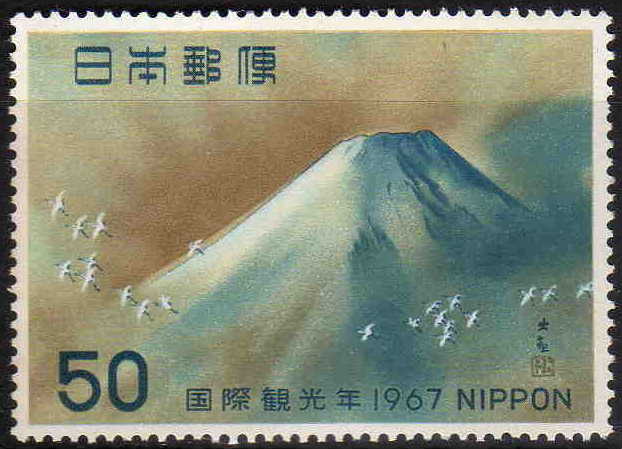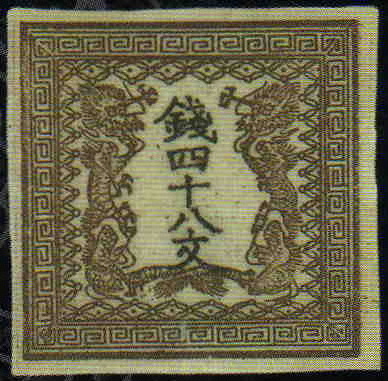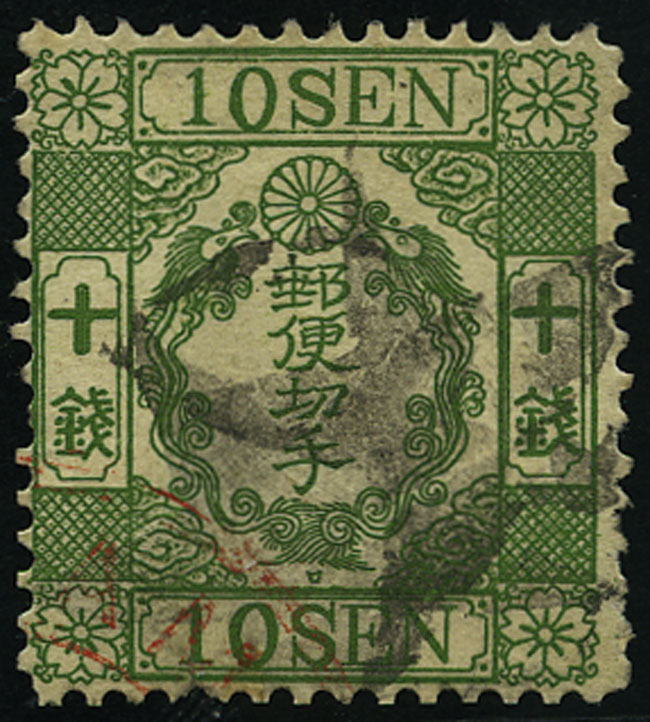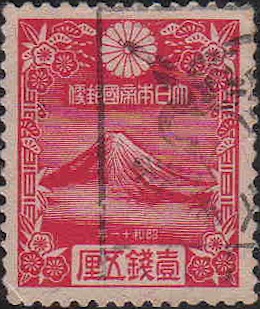Postage Stamps And Postal History Of Japan on:
[Wikipedia]
[Google]
[Amazon]
 The story of Japan's
The story of Japan's
 In 1870, Baron Maeshima visited London to learn the workings of the British postal system, and founded Japan's postal system in 1871. The first stamps were issued in April 1871, in a set of four covering the different postal rates; the intricate two-color design consisted of a pair of dragons facing towards the center, where the characters of value were printed in black. The denominations were in mon, which had already been superseded by the
In 1870, Baron Maeshima visited London to learn the workings of the British postal system, and founded Japan's postal system in 1871. The first stamps were issued in April 1871, in a set of four covering the different postal rates; the intricate two-color design consisted of a pair of dragons facing towards the center, where the characters of value were printed in black. The denominations were in mon, which had already been superseded by the  The new designs also included Latin letters for the denomination, a trend which has been generally followed since, and a chrysanthemum, which was on every Japanese stamp until 1947, in lieu of the actual visage of the emperor.
In 1876, a long
The new designs also included Latin letters for the denomination, a trend which has been generally followed since, and a chrysanthemum, which was on every Japanese stamp until 1947, in lieu of the actual visage of the emperor.
In 1876, a long  The first
The first
 1935 saw the first New Year's stamp, issued at the end of the year to pay postage on New Year's cards. It depicted Mount Fuji, as did the first of a long-running series of national parks issues, appearing in 1936.
A new definitive series in 1942 reflected Japan's entry into
1935 saw the first New Year's stamp, issued at the end of the year to pay postage on New Year's cards. It depicted Mount Fuji, as did the first of a long-running series of national parks issues, appearing in 1936.
A new definitive series in 1942 reflected Japan's entry into
File:Japan Stamp in 1958 International Letter Writing Week.JPG, 1958 International Letter Writing Week.
File:Japan Stamp in 1959 International Letter Writing Week.JPG, 1959 International Letter Writing Week.
File:Japan Stamp in 1961 International Letter Writing Week.JPG, 1961 International Letter Writing Week.
File:Japan Stamp in 1962 International Letter Writing Week.JPG, 1962 International Letter Writing Week.
 During the war, Japan issued a variety of
During the war, Japan issued a variety of

The International Society for Japanese Philately, Inc.
* Stamps of the Worl
{{Portal bar, Asia, Japan, Philately Postal system of Japan Philately of Japan
 The story of Japan's
The story of Japan's postal system
The mail or post is a system for physically transporting postcards, letters, and parcels. A postal service can be private or public, though many governments place restrictions on private systems. Since the mid-19th century, national postal syst ...
with its postage stamp
A postage stamp is a small piece of paper issued by a post office, postal administration, or other authorized vendors to customers who pay postage (the cost involved in moving, insuring, or registering mail), who then affix the stamp to the f ...
s and related postal history goes back centuries. The country's first modern postal service got started in 1871, with mail professionally travelling between Kyoto
Kyoto (; Japanese language, Japanese: , ''Kyōto'' ), officially , is the capital city of Kyoto Prefecture in Japan. Located in the Kansai region on the island of Honshu, Kyoto forms a part of the Keihanshin, Keihanshin metropolitan area along wi ...
and Tokyo
Tokyo (; ja, 東京, , ), officially the Tokyo Metropolis ( ja, 東京都, label=none, ), is the capital and List of cities in Japan, largest city of Japan. Formerly known as Edo, its metropolitan area () is the most populous in the world, ...
as well as the latter city and Osaka
is a designated city in the Kansai region of Honshu in Japan. It is the capital of and most populous city in Osaka Prefecture, and the third most populous city in Japan, following Special wards of Tokyo and Yokohama. With a population of ...
. This took place in the midst of the rapid industrialization and social reorganization that the Meiji period
The is an era of Japanese history that extended from October 23, 1868 to July 30, 1912.
The Meiji era was the first half of the Empire of Japan, when the Japanese people moved from being an isolated feudal society at risk of colonization ...
symbolized in Japanese history
The first human inhabitants of the Japanese archipelago have been traced to prehistoric times around 30,000 BC. The Jōmon period, named after its cord-marked pottery, was followed by the Yayoi period in the first millennium BC when new inventi ...
. Given how the nation's railroad technology was in its infancy, Japan's growing postal system relied heavily on human-powered transport
Human-powered transport is the transport of person(s) and/or goods using human muscle power. Unlike animal-powered transport, human-powered transport has existed since time immemorial in the form of walking, running and swimming. Modern techno ...
, including rickshaws
A rickshaw originally denoted a two- or three-wheeled passenger cart, now known as a pulled rickshaw, which is generally pulled by one person carrying one passenger. The first known use of the term was in 1879. Over time, cycle rickshaws (also ...
, as well as horse-drawn
A horse-drawn vehicle is a mechanized piece of equipment pulled by one horse or by a team of horses. These vehicles typically had two or four wheels and were used to carry passengers and/or a load. They were once common worldwide, but they have m ...
methods of delivery. For example, while commemorating the 50th anniversary of Japan's postal service, the country's 1921 government released decorative postcard
A postcard or post card is a piece of thick paper or thin cardboard, typically rectangular, intended for writing and mailing without an envelope. Non-rectangular shapes may also be used but are rare. There are novelty exceptions, such as wood ...
s depicting intrepid horseback riders carrying the mail. This however was done to compare postal transport in past and present, as the other card showed modern transportation viz. rail and shipping. The railroad net from the north to the south, Aomori to Nagasaki, was completed in 1889 (Meiji 21). Prior to 1920s, local delivery was mainly by men- and horsepower, not principally different to Europe.
In terms of communications
Communication (from la, communicare, meaning "to share" or "to be in relation with") is usually defined as the transmission of information. The term may also refer to the message communicated through such transmissions or the field of inquir ...
, British
British may refer to:
Peoples, culture, and language
* British people, nationals or natives of the United Kingdom, British Overseas Territories, and Crown Dependencies.
** Britishness, the British identity and common culture
* British English, ...
technicians had already been employed in assisting with Japanese lighthouses
A lighthouse is a tower, building, or other type of physical structure designed to emit light from a system of lamps and lenses and to serve as a beacon for navigational aid, for maritime pilots at sea or on inland waterways.
Lighthouses mar ...
, and the country's budding mail system looked to hybridize British ideas with local practicalities. Shipping
Freight transport, also referred as ''Freight Forwarding'', is the physical process of transporting commodities and merchandise goods and cargo. The term shipping originally referred to transport by sea but in American English, it has been ...
along the nation's coastline in particular demonstrates a key instance of how the Japanese economy
The economy of Japan is a highly developed social market economy, often referred to as an East Asian model. It is the third-largest in the world by nominal GDP and the fourth-largest by purchasing power parity (PPP). It is the world's seco ...
developed: the government closely working with private companies to industrially expand in a way that met social needs while also allowing for large profits. Mitsubishi's contract for mail transport by sea proved lucrative enough that it assisted with the firm becoming one of the famous "zaibatsu
is a Japanese term referring to industrial and financial vertically integrated business conglomerates in the Empire of Japan, whose influence and size allowed control over significant parts of the Japanese economy from the Meiji period unt ...
".
Since 2007, the nation's post office
A post office is a public facility and a retailer that provides mail services, such as accepting letters and parcels, providing post office boxes, and selling postage stamps, packaging, and stationery. Post offices may offer additional ser ...
s have been managed by the firm Japan Post Network
, was a Japanese company which operated the post office of Japan. It was part of the Japan Post Holdings group.
History
* October 1, 2007 - Operations commenced with the break-up and privatization of former Japan Post operating divisions.
* O ...
, which is itself a part of the larger Japan Post Holdings
is a Japanese publicly traded conglomerate headquartered in Kasumigaseki, Chiyoda, Tokyo. It is mainly engaged in postal and logistics business, financial window business, banking business and life insurance business. The company offers letters ...
conglomerate. As of December 2017, the smaller company has been managed by CEO Koji Furukawa. The simple Japanese postal mark
is the service mark of Japan Post and its successor, Japan Post Holdings, the postal operator in Japan. It is also used as a Japanese postal code mark since the introduction of the latter in 1968. Historically, it was used by the , which ope ...
, introduced in 1887, is still used to this day.
Influence of foreign post offices
Public posts would not be established until 1871; prior to that several nations maintained foreign post offices. The British maintained post offices inYokohama
is the second-largest city in Japan by population and the most populous municipality of Japan. It is the capital city and the most populous city in Kanagawa Prefecture, with a 2020 population of 3.8 million. It lies on Tokyo Bay, south of T ...
(opened 1859), Nagasaki
is the capital and the largest Cities of Japan, city of Nagasaki Prefecture on the island of Kyushu in Japan.
It became the sole Nanban trade, port used for trade with the Portuguese and Dutch during the 16th through 19th centuries. The Hi ...
(1860), and Kobe (1869), all closing in December 1879. From 1864 on, the offices used stamps of Hong Kong. France had an office in Yokohama from 1865 to 1880, using French stamps. The United States opened post offices in Yokohama and Nagasaki in 1867, in Kobe in 1868, and in Hakodate
is a city and port located in Oshima Subprefecture, Hokkaido, Japan. It is the capital city of Oshima Subprefecture. As of July 31, 2011, the city has an estimated population of 279,851 with 143,221 households, and a population density of 412.8 ...
in 1871, using US stamps, and closing in 1874.
First stamps
yen
The is the official currency of Japan. It is the third-most traded currency in the foreign exchange market, after the United States dollar (US$) and the euro. It is also widely used as a third reserve currency after the US dollar and the e ...
; the same basic design denominated in yen appeared in 1872, but was itself soon replaced by a new set of four designs featuring the imperial crest.
 The new designs also included Latin letters for the denomination, a trend which has been generally followed since, and a chrysanthemum, which was on every Japanese stamp until 1947, in lieu of the actual visage of the emperor.
In 1876, a long
The new designs also included Latin letters for the denomination, a trend which has been generally followed since, and a chrysanthemum, which was on every Japanese stamp until 1947, in lieu of the actual visage of the emperor.
In 1876, a long definitive series
A definitive stamp is a postage stamp that is part of the regular issue of a country's stamps, available for sale by the post office for an extended period of time and designed to serve the everyday postal needs of the country. The term is used in ...
was introduced, with a generally oval inner frame, and inscribed "IMPERIAL JAPANESE POST". Japan joined the UPU in 1877.
commemorative stamp
A commemorative stamp is a postage stamp, often issued on a significant date such as an anniversary, to honor or commemorate a place, event, person, or object. The ''subject'' of the commemorative stamp is usually spelled out in print, unlike defi ...
, in 1894, marked the 25th anniversary of the wedding of Emperor Meiji and Empress Shōken
, born , was the wife and adviser of Emperor Meiji of Japan. She is also known under the technically more correct name . She was one of the founders of the Japanese Red Cross Society, whose charity work was known throughout the First Sino-Japanese ...
. The first persons depicted were Prince Kitashirakawa Yoshihisa
of Japan, was the second head of a collateral branch of the Japanese imperial family. He was formerly enshrined in Tainan-Jinja, Taiwan, under the name ''Kitashirakawa no Miya Yoshihisa-shinnō no Mikoto'' as the main and only deity.
Biogra ...
and Prince Arisugawa Taruhito
was a Japanese career officer in the Imperial Japanese Army, who became the 9th head of the line of '' shinnōke'' cadet branches of the Imperial Family of Japan on September 9, 1871.
Early life
Prince Arisugawa Taruhito was born in Kyoto in ...
, honored in 1896 for their role in the First Sino-Japanese War
The First Sino-Japanese War (25 July 1894 – 17 April 1895) was a conflict between China and Japan primarily over influence in Korea. After more than six months of unbroken successes by Japanese land and naval forces and the loss of the ...
that had ended the previous year.
Twentieth century
 1935 saw the first New Year's stamp, issued at the end of the year to pay postage on New Year's cards. It depicted Mount Fuji, as did the first of a long-running series of national parks issues, appearing in 1936.
A new definitive series in 1942 reflected Japan's entry into
1935 saw the first New Year's stamp, issued at the end of the year to pay postage on New Year's cards. It depicted Mount Fuji, as did the first of a long-running series of national parks issues, appearing in 1936.
A new definitive series in 1942 reflected Japan's entry into World War II
World War II or the Second World War, often abbreviated as WWII or WW2, was a world war that lasted from 1939 to 1945. It involved the vast majority of the world's countries—including all of the great powers—forming two opposing ...
, with designs including war workers and saluting aviators. They were superseded by a new series in 1945 and another in 1946, crudely printed and issued imperforate.
In accordance with UPU regulations, in 1966, Japanese started including the name "NIPPON" in Latin characters in addition to the Latin-character denomination.
From 1989 to 2007, prefecture stamps appeared. Although valid for postage throughout the country, the designs are specific to the prefecture and are only sold in the prefecture's postal region. From 2008, prefectural issues were available for sale nationwide. Moreover, the calligraphic style of the characters for "Japan Post" on each stamp were changed to reflect the style used in non-prefecture issues for most stamps.
The postal system was reorganized in 2003 with the creation of Japan Post
was a Japanese statutory corporation that existed from 2003 to 2007, offering postal and package delivery services, banking services, and life insurance. It's the nation's largest employer, with over 400,000 employees, and runs 24,700 po ...
.
World War II issues
 During the war, Japan issued a variety of
During the war, Japan issued a variety of overprint
An overprint is an additional layer of text or graphics added to the face of a Postage stamp, postage or revenue stamp, postal stationery, banknote or Ticket (admission), ticket after it has been Printing, printed. Post offices most often use ...
s and new designs for its occupied territories
Military occupation, also known as belligerent occupation or simply occupation, is the effective military control by a ruling power over a territory that is outside of that power's sovereign territory.Eyāl Benveniśtî. The international law ...
.
Allied occupation
At the end of World War II, between October 1946 and February 1949, Australian stamps overprinted "B.C.O.F. / JAPAN / 1946" were used by theBritish Commonwealth Occupation Force
The British Commonwealth Occupation Force (BCOF) was the British Commonwealth taskforce consisting of Australian, British, Indian and New Zealand military forces in occupied Japan, from 1946 until the end of occupation in 1952.
At its peak, ...
in Allied occupied Japan .
Post Offices Abroad
Japan issued stamps for use at its post offices in China (1876–1922) and Korea (1876–1905).Postal symbol
The symbol for a post office in Japan is a stylized katakana syllable te ( テ),〒
is the service mark of Japan Post and its successor, Japan Post Holdings, the postal operator in Japan. It is also used as a Japanese postal code mark since the introduction of the latter in 1968. Historically, it was used by the , which oper ...
. This is used on the signs of post offices, on post boxes, and before the postcode on envelopes and packages. It is derived from the Japanese word .
The symbol can be obtained by typing ''yuubin'' in a Japanese word processor and then converting it. There are several variant forms of this symbol in Unicode
Unicode, formally The Unicode Standard,The formal version reference is is an information technology standard for the consistent encoding, representation, and handling of text expressed in most of the world's writing systems. The standard, wh ...
, including a form in a circle, 〶 (Unicode U+3036), which is the official Geographical Survey Institute of Japan
The , or GSI, is the national institution responsible for surveying and mapping the national land of Japan. The former name of the organization from 1949 until March 2010 was Geographical Survey Institute; despite the rename, it retains the same ...
map symbol
A map symbol or cartographic symbol is a graphical device used to visually represent a real-world feature on a map, working in the same fashion as other forms of symbols. Map symbols may include point markers, lines, regions, continuous fields, ...
for a post office. It also appears in 🏣 (Unicode U+1F3E3), an emoji representing a (specifically Japanese) post office, as the sign on the building.
〠 (Unicode U+3020) is a character of Japan Post. Its name is Number- kun. Japan Post released a new character, "Poston", in 1998, so Number-kun is rarely used nowadays.
See also
*Communications in Japan
The nation of Japan currently possesses one of the most advanced communication networks in the world. For example, by 2008 the Japanese government's Internal Affairs and Communications Ministry stated that about 75 million people used mobile ...
* Postage stamps and postal history of Ryukyu Islands
References
Sources
* Stanley Gibbons Ltd: various catalogues * Mackay, James. A. ''The World Encyclopedia of Stamps and Stamp Collecting''. Lorenz Books, 2005. * Rossiter, Stuart & John Flower. ''The Stamp Atlas''. London: Macdonald, 1986.Further reading
* Casey, Ron and Kenneth Kamholz. ''Cumulative index to Japanese Philately, Volumes 1-60 (1946-2005)''. Haddonfield N.J.: International Society for Japanese Philately, 2006 * Ministry of Postal Services. ''Japan and her postal service''. Tokyo: Maejima Society, 1961 106p. * Peplow, F.J. ''Plates of the Stamps of Japan 1871-76''. London: F.J. Peplow, 1910. (Privately printed - 25 copies.) * Tatsuji, Nishioka. ''65 Years in Stamps: A Philatelic History of the Shōwa Period''; translated and edited by Scott Gates and Robert Elliott. Limassol, Cyprus: James Bendon, 1994 , 128p. * Woodward, A. M. Tracey. ''The Postage Stamps of Japan and Dependencies''. London: Harris Publications; Tokyo; Shanghai printed: S. Mayéba, 1928 (Two volumes - only 100 copies printed). Partially reprinted by Quarterman Publications in 1976. * Yamamoto, Yokiti. ''Japanese Postage Stamps (for philatelists)''. Tokyo: Board of Tourist Industry, Japanese Government Railways, 1940 105p.External links
The International Society for Japanese Philately, Inc.
* Stamps of the Worl
{{Portal bar, Asia, Japan, Philately Postal system of Japan Philately of Japan